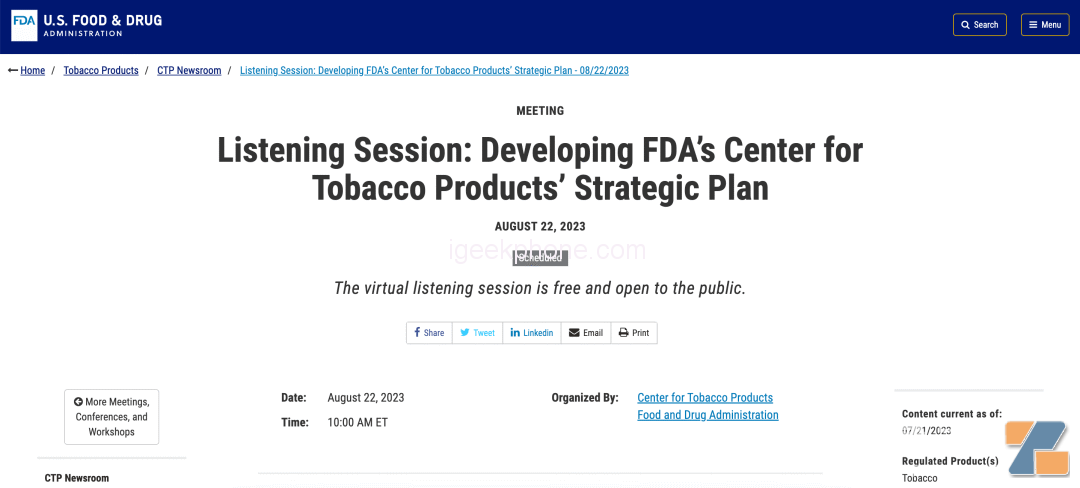According to the agency’s ongoing updates on the FDA’s progress, this public hearing stems from the FDA’s implementation of recommendations from the Reagan-Udall Foundation (RUF) review received last December. At the time, the Reagan-Udall Foundation evaluated the FDA’s work in PMTA related areas: “The FDA’s regulation of e-cigarettes lacks a clear, comprehensive long-term plan, regulatory standards are vague, complex and unnecessary, and there is a lack of principles.” As a result, the FDA has also conducted a series of internal combing and rectification based on relevant evaluation recommendations. On June 29, Brian King, director of the FDA’s Center for Tobacco Products (CTP), announced the results of the work and outlined plans, including: 1, the CTP is expected to develop a strategic plan this summer and issue a final plan by December 2023. The Office of the CTP Ombudsman is leading the development of an operational plan to improve transparency and information sharing across all programs, including through the establishment of a transparency focal point. The CTP plans to hold a public meeting in the summer of 2023 to seek input from tobacco industry stakeholders on the strategic plan. The CTP reviewed PMTA applications submitted for e-cigarettes over the past three years, authorizing 23 types of tobacco-flavored e-cigarettes. The CTP is currently planning to hold a public meeting in the fall of 2023 to discuss the PMTA application review process. The CTP has recently imposed new requirements on tobacco product manufacturers regarding the manufacture, design, packaging and storage of their products. 7, the CTP is finalizing regulations related to menthol cigarettes and flavored cigars to issue a proposed rule that would determine maximum nicotine content to reduce addiction. From this point of view, the public hearing to be held on August 22 is mainly aimed at the implementation of the first and third items. According to King’s previous public statements, the FDA is moving forward on the above matters according to the schedule. For the e-cigarette industry, the continued advancement of this program means that the window for products that have not yet applied for PMTA in the U.S. market is accelerating. In our tweet “Dialogue Zheng Zhi: PMTA enters a critical period in the second half of the year, and the US market will usher in big changes”, we conducted a detailed analysis based on various evidence, and gave a prediction: Starting in March this year, PMTA will enter a sprint period. Not only will there be a large number of alerts, warning letters, denial orders issued in the second half of the year, but the relevant processes of the FDA will also be further improved, and the “real effect” of PMTA is a large probability at the end of 2023.
On July 21, the FDA’s Center for Tobacco Products (CTP) will hold an online public hearing on the development of a five-year strategic plan on August 22, 2023. At this hearing, the FDA will present its proposed strategic plan around the following five areas. According to the FDA’s official statement, they are:
1. Develop, promote and publicize comprehensive and impactful tobacco regulations and guidelines. This objective includes activities related to the development and implementation of the regulatory and policy agenda of the Center for Tobacco Products (CTP); Formulate and publish clear and comprehensive public policy statements; And work to promote health equity. Ensure timely, clear and consistent product application reviews to protect public health. This objective includes workflow-related activities such as optimizing the efficiency, consistency and effectiveness of the product application review process; Improve public understanding of regulatory requirements by promoting transparency and engaging practitioners; And ensuring that the review process is supported by a strong regulatory science program. Use all available tools, including strong enforcement actions, to ensure compliance of regulated industries and tobacco products. This objective includes enforcement action to reduce violations; Strengthening cooperation with federal and state agencies on tobacco enforcement efforts; Priority is given to flexible market intelligence and monitoring to promote awareness and effective responses to the changing tobacco environment. 4. Improve public health by increasing awareness and understanding of the Tobacco Control Plan’s tobacco product regulations and the risks associated with the use of tobacco products. This objective includes timely, clear and understandable health information and education to different public audiences, including discouraging youth from smoking, encouraging cessation, and educating adults who smoke about the relative risks of tobacco products. 5. Drive greater operational excellence. The goal includes prioritizing workforce growth, engagement and retention, as well as CTP’s commitment to diversity, equity, inclusion and accessibility; Modernize business processes to improve information management and planning efficiency; Seek and apply the resources needed to support the CTP’s full portfolio of regulatory activities.

.jpg)








